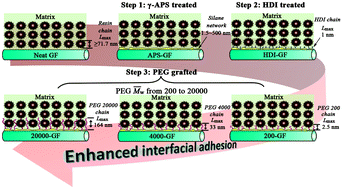Control interfacial properties and tensile strength of glass fibre/PP composites by grafting poly(ethylene glycol) chains on glass fibre surface
Abstract
To control the interphase properties of glass fibre/PP composites, poly(ethylene glycol) (PEG) chains with different average molar mass (![[M with combining macron]](https://www.rsc.org/images/entities/i_char_004d_0304.gif) w) were grafted onto the glass fibre surface by treating the fibres with γ-APS, HDI and PEG stepwise. The interfacial adhesion of composites was studied as a function of the
w) were grafted onto the glass fibre surface by treating the fibres with γ-APS, HDI and PEG stepwise. The interfacial adhesion of composites was studied as a function of the ![[M with combining macron]](https://www.rsc.org/images/entities/i_char_004d_0304.gif) w of PEG chain grafted on the glass surface. The contact angle measurement, ATR-FTIR, XPS and AFM analysis for the grafted glass fibres (GFs) proved that the PEG chains were grafted onto the GF surface successfully. The increasing roughness of the GF surface confirms that the lengths of the grafted chains grow as the
w of PEG chain grafted on the glass surface. The contact angle measurement, ATR-FTIR, XPS and AFM analysis for the grafted glass fibres (GFs) proved that the PEG chains were grafted onto the GF surface successfully. The increasing roughness of the GF surface confirms that the lengths of the grafted chains grow as the ![[M with combining macron]](https://www.rsc.org/images/entities/i_char_004d_0304.gif) w of PEG increases. The single fibre strength was measured and the data were analyzed by using the two-parameter Weibull model. The results showed that the grafting of PEG on the GF surface lead to a slightly reduced tensile strength and Weibull modulus. The tensile strength of the unidirectional GF reinforced PP composites was tested from 90° and 0° off-axis. It is found that grafting PEG chains onto the GF surface by this three-stage method is an effective means to improve the interfacial adhesion and transverse and longitudinal tensile properties of GF/PP composites. The results showed that as the
w of PEG increases. The single fibre strength was measured and the data were analyzed by using the two-parameter Weibull model. The results showed that the grafting of PEG on the GF surface lead to a slightly reduced tensile strength and Weibull modulus. The tensile strength of the unidirectional GF reinforced PP composites was tested from 90° and 0° off-axis. It is found that grafting PEG chains onto the GF surface by this three-stage method is an effective means to improve the interfacial adhesion and transverse and longitudinal tensile properties of GF/PP composites. The results showed that as the ![[M with combining macron]](https://www.rsc.org/images/entities/i_char_004d_0304.gif) w of PEG increased, the interfacial adhesion of the composites improved.
w of PEG increased, the interfacial adhesion of the composites improved.


 Please wait while we load your content...
Please wait while we load your content...